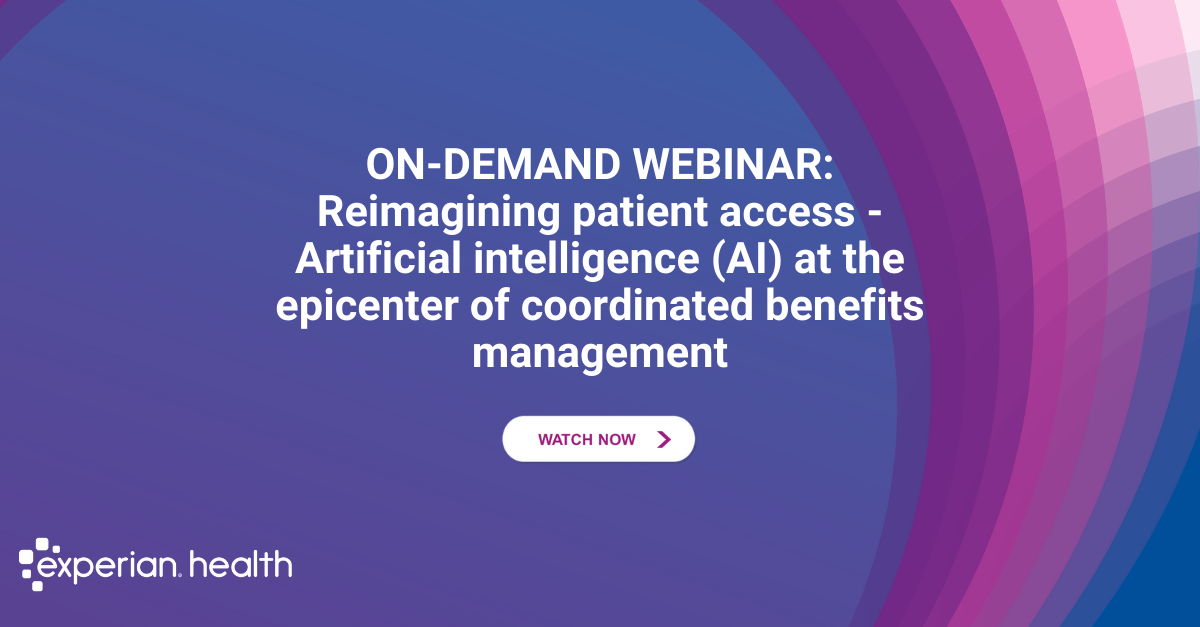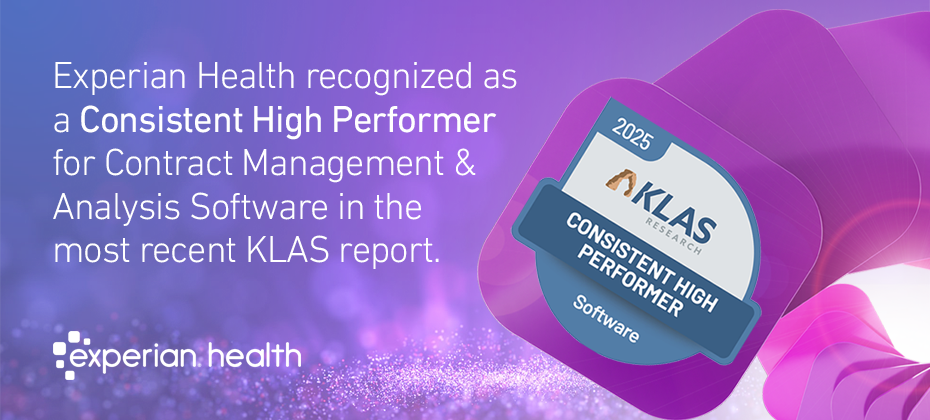
For patient access leaders at large healthcare organizations, the pressure is mounting and has been building for some time.
Healthcare claim denials are climbing. Staffing is stretched, and the tools healthcare organizations have relied on for years are no longer enough. But what if providers could stop denials before they start?
Welcome to the new era of denial prevention in healthcare, powered by predictive intelligence. Experian Health’s innovative artificial intelligence (AI) solutions, Patient Access Curator and AI Advantage™, were designed to help organizations prevent denials before they occur.
The denial spiral explained: A systemic challenge in revenue cycle management
Claim denials aren’t just a back-end billing issue. They’re a symptom of upstream breakdowns—often rooted in inaccurate or incomplete patient data at registration. According to Experian Health’s 2024 State of Claims Survey, 46% of denials are caused by missing or incorrect information. And the cost of reworking a denied claim? $25 for providers and $181 for hospitals.
The result? A denial spiral that drains resources, delays reimbursements, and frustrates patients and staff alike.
Why Epic users are especially vulnerable
While Epic is a powerful EHR platform, many Epic-based organizations still rely on staff to make complex decisions at registration.
Questions like:
- Is this coverage primary?
- Should discovery be run?
- Is this data accurate?
…are often left to frontline staff. This guesswork leads to inconsistent outcomes—and denials.
What’s needed is a layer of predictive intelligence that works within Epic to automate and correct data before it becomes a problem.
How Patient Access Curator fixes registration errors
Patient Access Curator is that layer.
Patient Access Curator is an all-in-one solution that automatically finds and corrects patient data across eligibility, Coordination of Benefits (COB) primacy, Medicare Beneficiary Identifiers (MBI), demographics and insurance discovery—within seconds. It integrates directly into Epic workflows, eliminating the need for staff to toggle between systems or make judgment calls on the fly.
Instead of relying on registrars to catch every error, Patient Access Curator uses machine learning and predictive analytics to:
– Identify and correct bad data in real time
– Return comprehensive coverage directly into Epic
– Reduce denials, write-offs, and vendor fees
– Improve staff morale by removing administrative burden
As one early-adopting Patient Access Curator client puts it: “If your current workflow still depends on frontline decisions, you’re not just risking denials—you’re building them in.”
Predictive intelligence in healthcare: AI Advantage at work
While Patient Access Curator fixes the front end, AI Advantage tackles the middle of the revenue cycle, where claims are scrubbed, edited, and submitted.
At Schneck Medical Center, AI Advantage helped reduce denials by 4.6% per month and cut denial resolution time by 4x. The tool flags high-risk claims before submission and routes them to the right biller for correction. It also triages denials based on the likelihood of reimbursement, so staff can focus on the claims that matter most.
Together, Patient Access Curator and AI Advantage form a closed-loop system:
– Patient Access Curator ensures clean data at registration
– AI Advantage predicts and prevents denials mid-cycle
– Both tools integrate seamlessly with Epic and ClaimSource®
Why predictive denial prevention matters for patient access leaders
By implementing denial management technology and predictive intelligence, healthcare teams aren’t just managing workflows; they’re managing risk. Every inaccurate field, every missed coverage, every manual decision is a potential denial.
Patient Access Curator and AI Advantage remove that risk by replacing guesswork with certainty.
And the benefits go beyond revenue:
– Fewer denials mean fewer patient callbacks and less frustration
– Cleaner data means faster reimbursements and fewer write-offs
– Automation means staff can focus on patients, not paperwork
As Jason Considine, President at Experian Health, recently shared: “Our mission is to simplify healthcare. That starts by getting it right the first time, before a claim is ever submitted. With the power of AI and predictive intelligence, we’re no longer waiting for denials to happen;we’re helping providers proactively prevent them. Tools like Patient Access Curator and AI Advantage allow healthcare organizations to identify issues at the point of registration and throughout the revenue cycle, so teams can focus on care, not corrections. It’s about working smarter, reducing risk and protecting revenue.“
Denial prevention checklist: Preparing patient access teams for predictive denial prevention
Denial prevention is here, but what if billing teams aren’t quite ready? To move toward a predictive denial prevention strategy, healthcare organizations can invest in the following five areas:
- Audit front-end workflows
Map out every step from patient registration to claim submission. Identify where manual decisions are being made—especially around eligibility, COB, and insurance discovery. Ask: “Where are we relying on staff judgment instead of system intelligence?” - Train staff on data quality awareness
Reinforce the impact of inaccurate or incomplete data on downstream denials. Use real examples to show how a single missed field can lead to rework, write-offs, or patient frustration. Introduce the concept of “first-touch accuracy” as a team-wide goal. - Evaluate Epic integration readiness
Assess whether current Epic environments are configured to support automation tools like Patient Access Curator. Work with IT to assess whether the current setup allows for real-time data correction and coverage updates. Confirm that teams understand how new tools will integrate into their existing workflows, not replace them. - Establish a denial prevention task force
Bring together leaders from patient access, billing, IT and revenue cycle to align on goals. Assign ownership for key metrics like clean claim rate, denial rate, and registration accuracy. Use this group to pilot new tools like Patient Access Curator and AI Advantage and gather feedback from frontline users. - Communicate the “Why” behind the change
Frame automation as a way to reduce burnout, not replace jobs. Highlight how tools like Patient Access Curator eliminate guesswork and free up staff to focus on patient care. Share success stories from peers (like Schneck Medical Center) to build confidence and momentum.
The bottom line: Strategic denial prevention is the future
Denial management is reactive. Denial prevention is strategic. For healthcare organizations using Epic, Patient Access Curator and AI Advantage offer a smarter, faster and more scalable way to increase reimbursements and improve the patient experience.
Learn more about how Experian Health can help protect revenue, reduce staff burdens and reduce claim denials—starting at the first touchpoint.



